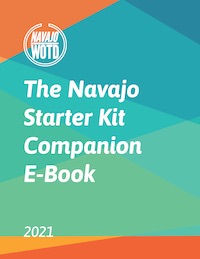ílį́įgo naalyéhé
jewelry
The Navajo words ílį́įgo naalyéhé together refer to jewelry.
The first word comes from the particle ílį́, which denotes value, worth, or genuineness (in a word like ílį́k’ehgo it means ‘with respect’ or ‘respectfully’).
Naalyéhé means property, or goods, in Navajo and is literally ‘that which is carried [about]’.
So, ílį́įgo naalyéhé is like saying a good with particular worth.
Navajo jewelry is regarded for featuring turquoise stones worked into silver, which reflects the style of the region. Squash blossoms adorn necklaces that range in style from pendants to heavy chains that are fully embellished to the back of the neck. For earrings, men tend to have simple turquoise stones while women have more intricate and striking designs. Concho belts featured designs carved or stamped into flat pieces that lay against the leather strap. Bow guards can also feature heavy silver and turquoise accents.
The old Navajo silversmiths learned to work metal and stone using techniques spread by early Spanish settlers via other tribes in the Southwest. It was common for tools to be fashioned out of scrap metal, such as railroad spikes or pieces of old engines. Raw materials were bartered for but only when absolutely necessary. Additionally, coins from back in the day were common ornaments in bracelets and belts.
See also:
- Díkwíí baah ílį́? (How much is it (worth; cost)?)
- Dootłizh (Turquiose, green, blue)
Original post date: .
